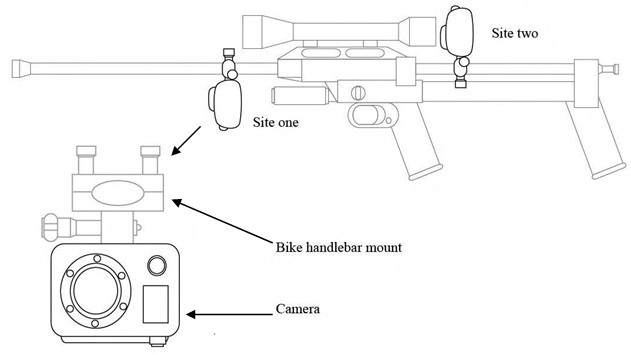The Use of Rifle Mounted Cameras for Training and Reviewing Remote Chemical Immobilization Techniques
Abstract
Training in remote chemical immobilization techniques is currently limited to practical teaching, on the job experience and literature review. The use of video review of techniques is practiced across a range of sports and allows critical review of personal technique. When applied to remote chemical immobilization systems the recordings can be used for personal audit of skills and the production of digital video for training inexperienced veterinarians or capture care teams. The welfare of the animal being darted is improved but the technique also allows an increase in performance with implications for cost, efficiency and reputation.
Introduction
In the United Kingdom remote chemical immobilization equipment is governed by the Home Office and requires a firearms license, with dart rifles and blowpipes being classed as Section Five firearms (this includes mini-guns and uzis). As such it is difficult to obtain training and expertise in the use of these systems prior to application for a firearms certificate. There are several references on appropriate use of dart equipment and management of the patient at the time of darting.1-3 In addition the dart rifle manufacturer’s instruction manual provides some information. However there is a lack of information regarding problems that may occur during the darting procedure and how to overcome these or minimize their incidence. Often this knowledge comes from practice and learning on the job.
Digital video recording of technique has been used for years in many sports to assess the ability of individuals and to allow critical review of technique. The authors felt that this technique could be used with remote chemical immobilization. Initially the primary objective was the production of teaching materials for undergraduate students, however it was realized that this technique had benefits for clinical audit of personal ability and development for the individual practitioner actively darting. Digital video recording of darting procedures was documented over 3 yr initially using a normal digital camera with video properties, evolving into the use of a rifle mounted extreme sports camera.
Materials and Methods
A standard protocol was developed for darting procedures, using digital video recording. A Dan-Inject JM Special, carbon dioxide powered rifle (Dan-Inject, Taunton, Somerset, TA4 1YX, England) was used in all of the darting procedures. The first camera system used was a Canon G9 (Canon UK Ltd, Reigate, Surrey, RH2 8BF, England) recording in an audio video interleave format. The dart rifle operator would be accompanied by an assistant using a range finder that would also operate the camera. Filming would include the dart rifle operator and the animal to be darted. The GoPro Hero (Woodman Labs, Inc, Half Moon Bay, California, 94019, USA) extreme sports camera was then selected due to the 180o field of view and the range of attachments that can be used to attach it to the rifle itself. The GoPro Hero recorded in a MP4 format requiring no post download modification compared to the previous systems used. A bicycle handle bar mount was used to attach the camera to the barrel in a ventral position (Figure 1, site one). In some instances it was attached in a dorsal position, caudal to the telescopic sites allowing visualization through the scope (Figure 1, site two).
Figure 1. Camera placement

All videoed sessions were reviewed and analyzed by the author within twenty-four hours. Criteria recorded included date; operator; species; reason for darting; distance; pressure; system; volume of dart; darting attempts; duration of darting attempt; accuracy of darting; success of discharge; darting injury; and any other comments. Changes were implemented in the darting technique and methods in response to monthly reviews to assess impact of the changes.
Discussion
The use of digital video recording is a cheap and effective method for the review and professional development of remote chemical immobilization skills. For the individual the video can be used for review of successful and unsuccessful darting events, allowing improvements to be made in skill and technique. A periodic review of darting skill also benefits the overall darting program. Increased efficiency and a reduction in darting failures improves animal welfare, decreases waste of immobilizing agents and insures that equipment is functioning correctly.
The development of a library of darting procedures and videos allows teaching materials to be developed that can be used as instruction tools by students, inexperienced veterinarians or capture teams. This provides material that depicts successful and unsuccessful darting events and the possible sequelae that may occur if darting is undertaken inappropriately and discuss the approach to how they should be managed.
Literature Cited
1. Harthoorn AM. The Chemical Capture of Animals. Bailière Tindall, London; 1976.
2. Kock MD, Meltzer D, Burroughs R. Chemical and Physical Restraint of Wild Animals. International Wildlife Veterinary Service, South Africa; 2006.
3. Kreeger TJ, Arnemo JM, Raath JP. Handbook of Wildlife Chemical immobilization: International Edition. Wildlife Pharmaceuticals Inc, Fort Collins, Colorado; 2002.
4. Nielsen L. Chemical Immobilization of Wild and Exotic Animals. Iowa State University Press, Ames, Iowa; 1999.